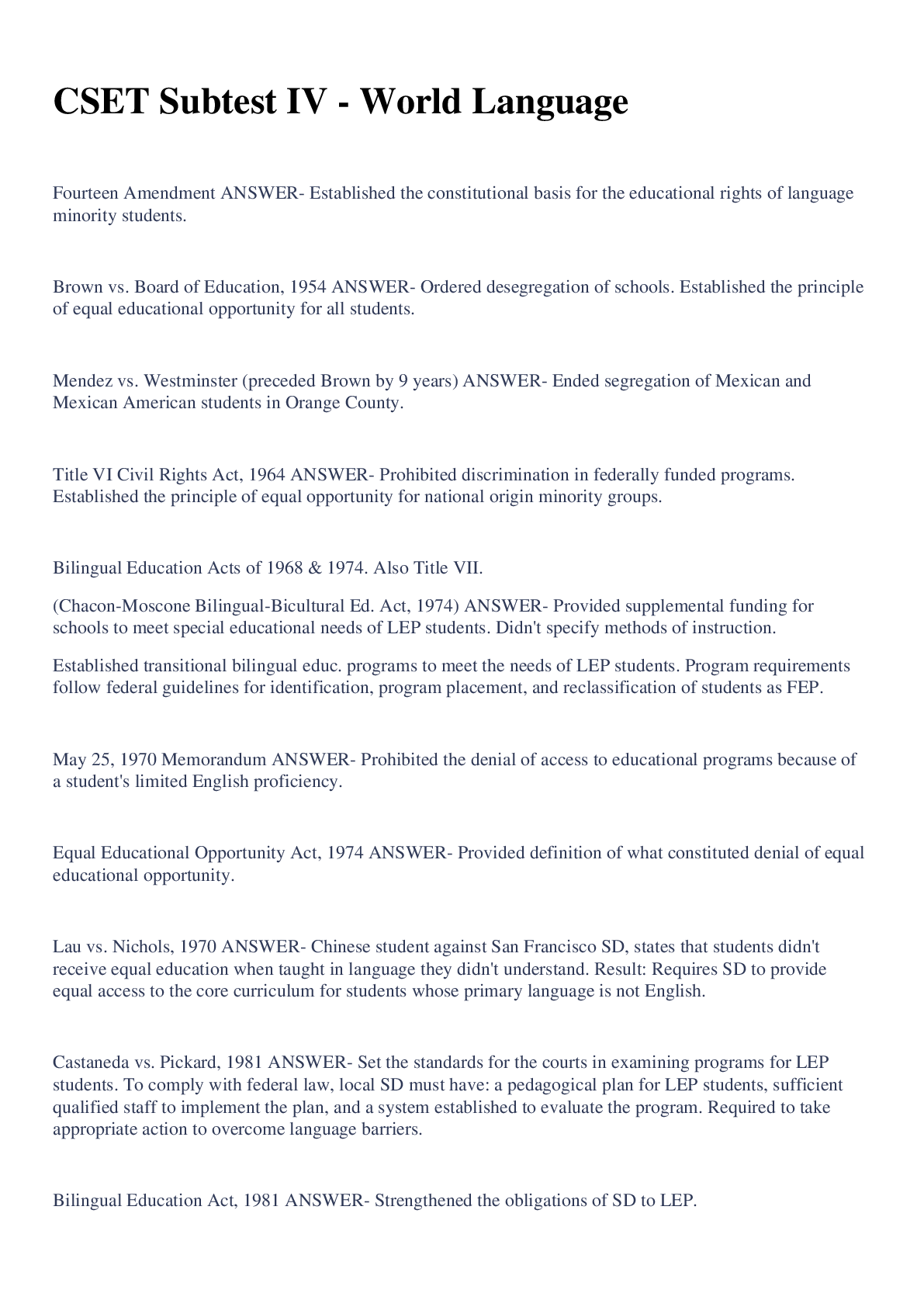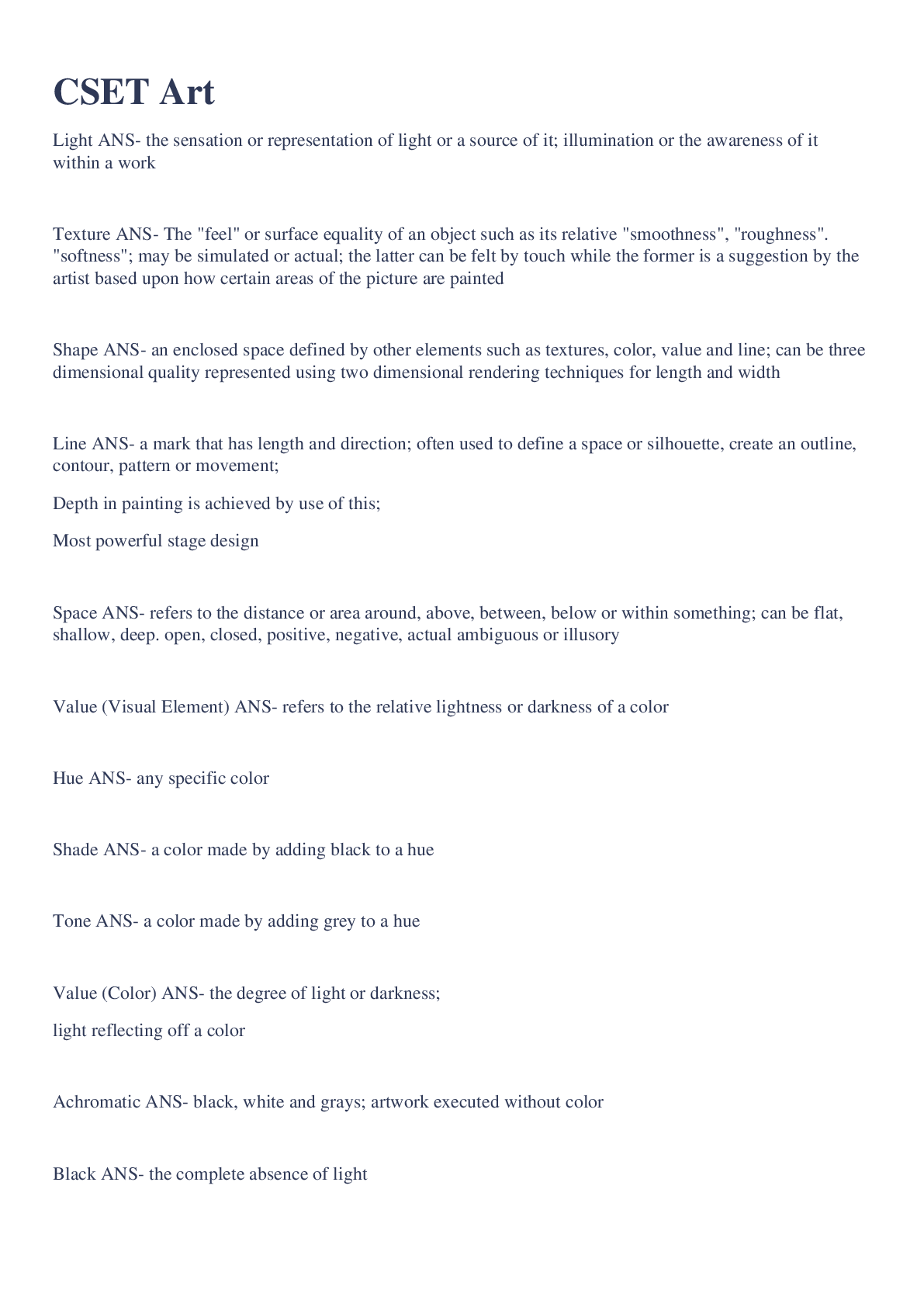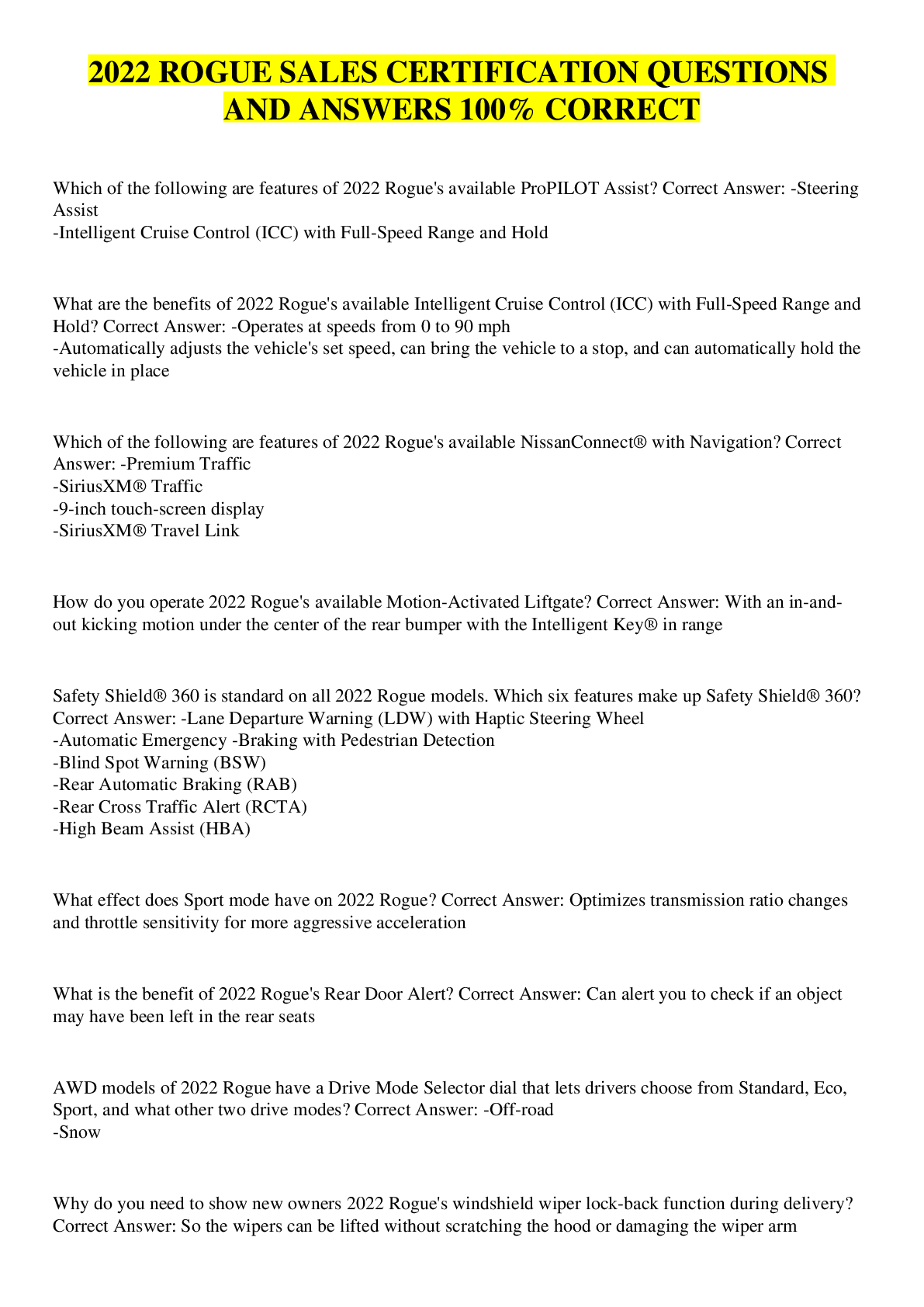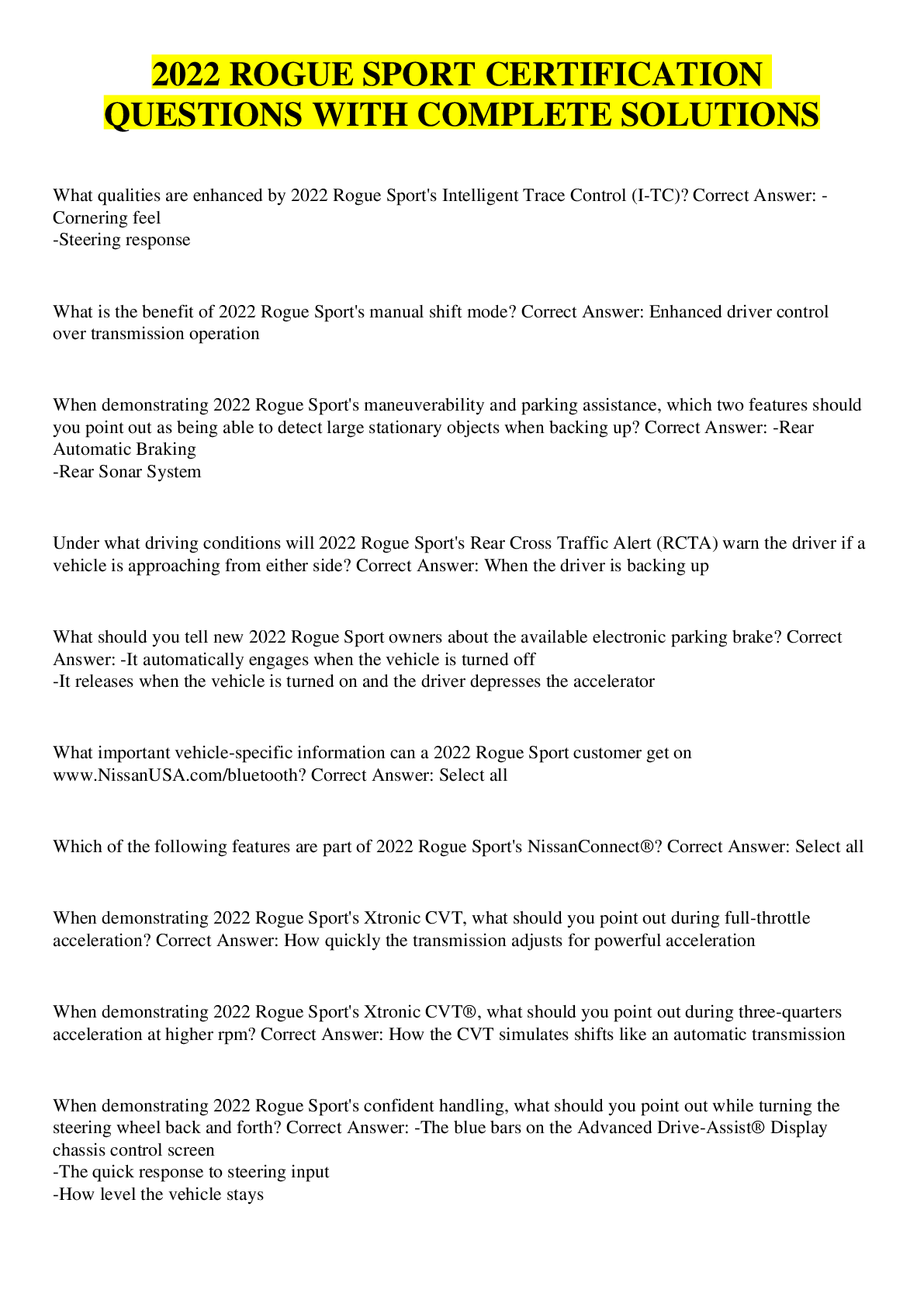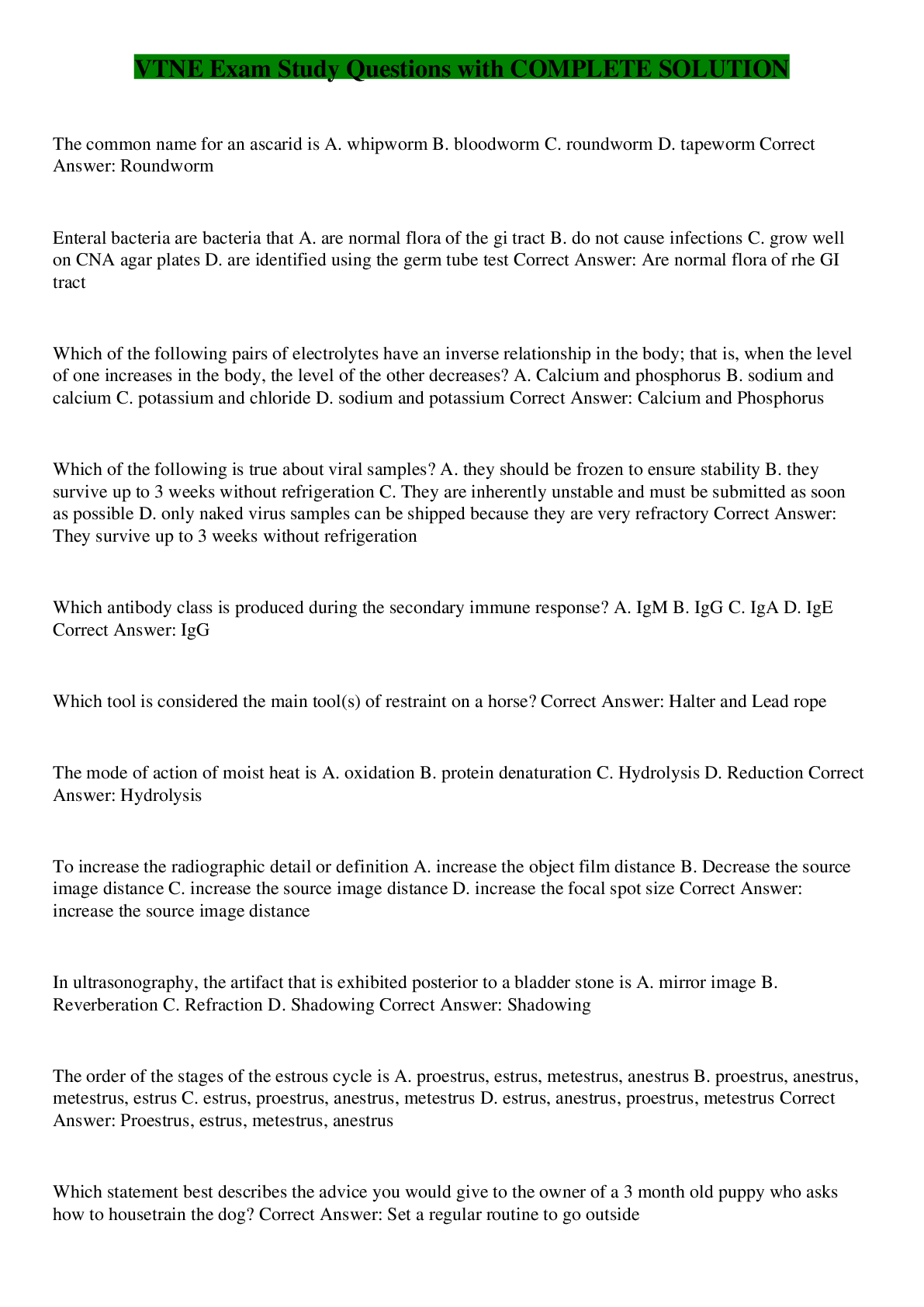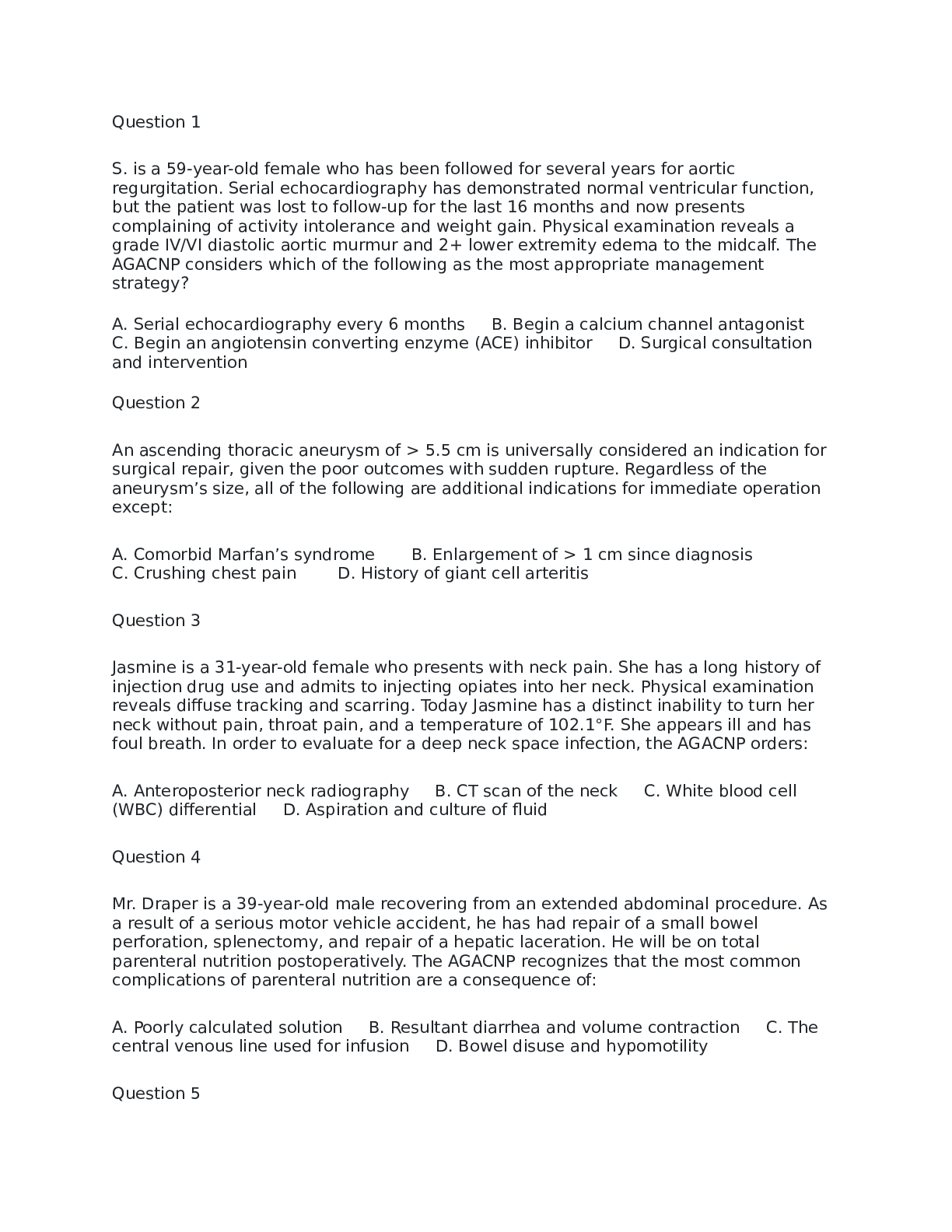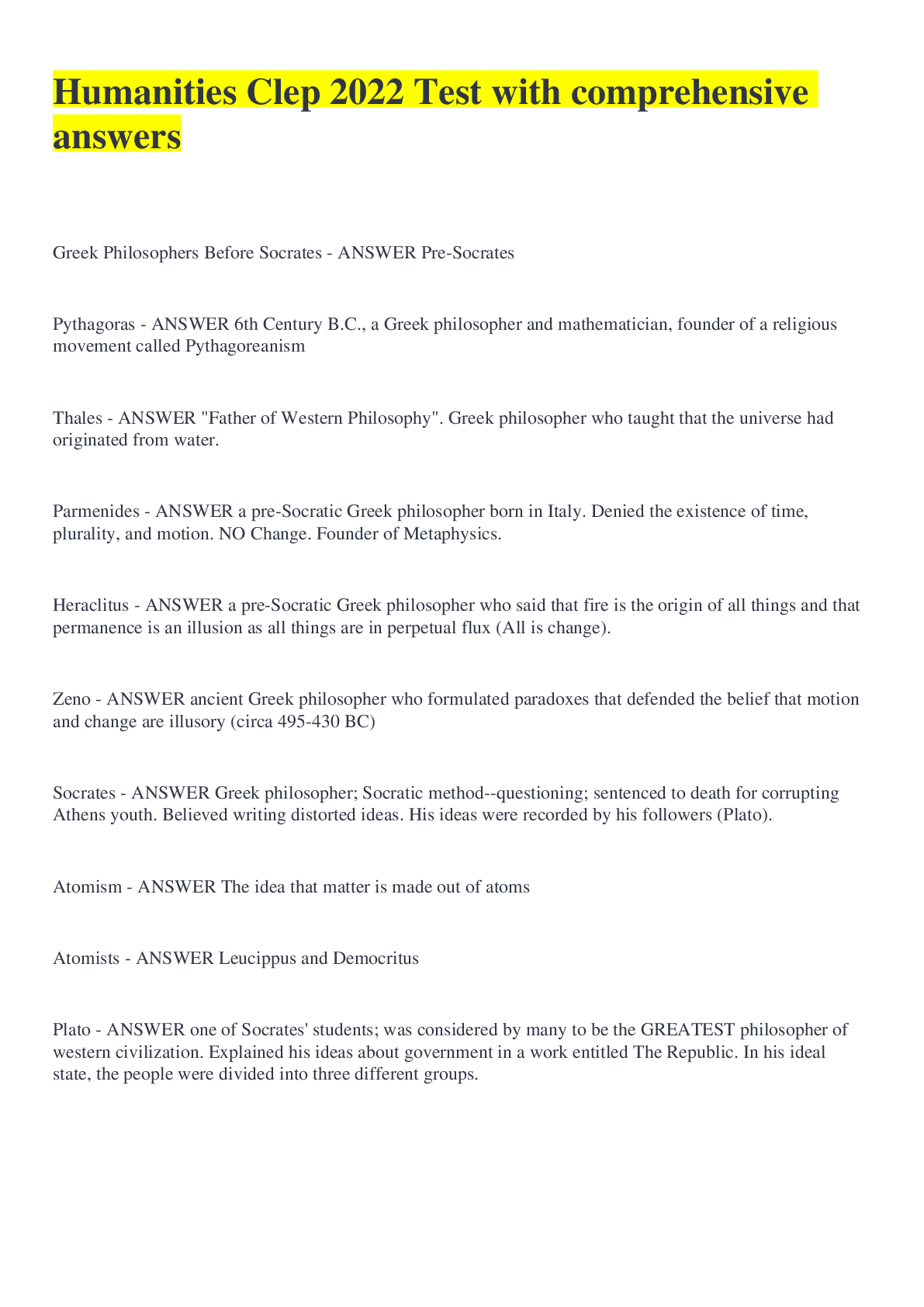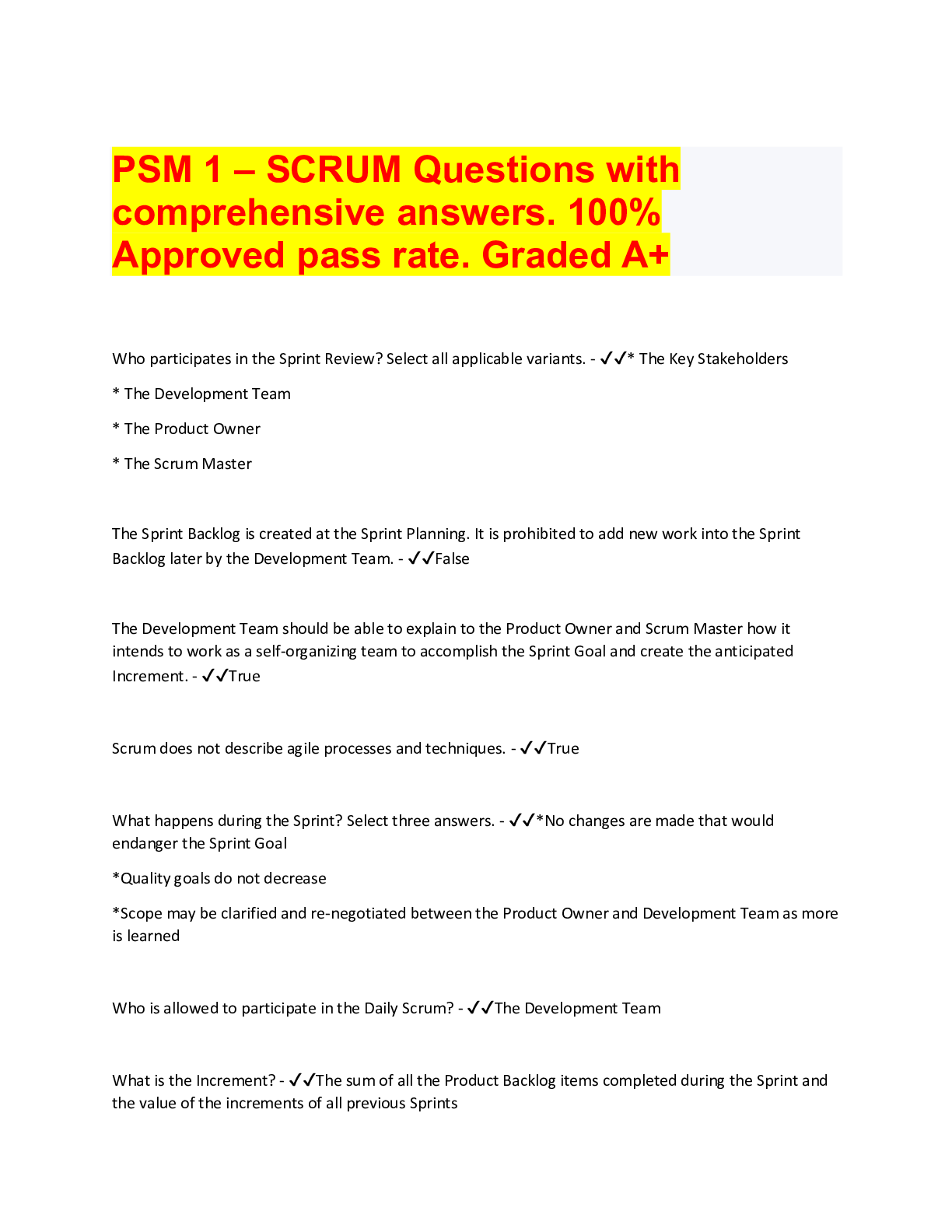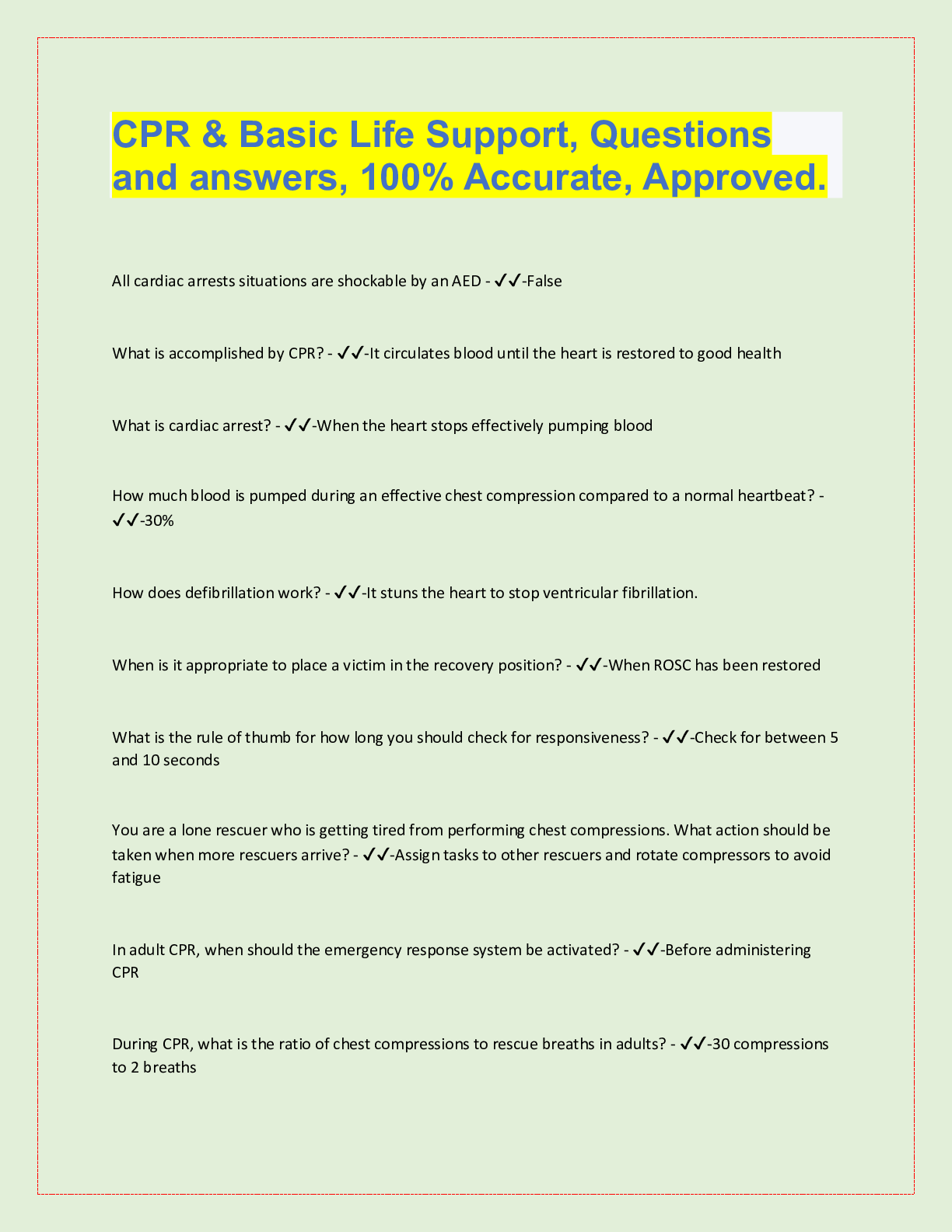Health Care > QUESTIONS & ANSWERS > AAFP Family Medicine| 533 Questions| WITH COMPREHENSIVE ANSWERS (All)
AAFP Family Medicine| 533 Questions| WITH COMPREHENSIVE ANSWERS
Document Content and Description Below
AAFP Family Medicine| 533 Questions| WITH COMPREHENSIVE ANSWERS Pioglitzaone thiazolidinediones (TZDs) are associated with fluid retention, and their use can be complicated by the development of... heart failure. Caution is necessary when prescribing TZDs in patients with known heart failure or other heart diseases, those with preexisting edema, and those on concurrent insulin therapy Correct Answer: A 70yo M with h/o HTN and DM presents with a 2-mo h/o increasing paroxysmal nocturnal dyspnea and SOB with minimal exertion. An echocardiogram shows an ejection fraction of 25%. Which one of the patients current medications should be discontinued? A. Lisinopril (Zestril) B. Pioglitazone (Actos) C. Glipizide (Glucotrol) D. Metoprolol (Toprol-XL) Renal Parenchymal Disease The most common cause of hypertension is renal parenchymal disease, and a urinalysis, urine culture, and renal ultrasonography should be ordered for all children presenting with hypertension. Correct Answer: What is the most common cause of hypertension in children under 6 years of age? Refer for cardiac resynchronization therapy (CRT) Note: he's already on maximum doses of ACEI, loop diuretic, beta-blocker Using a pacemaker-like device, CRT aims to get both ventricles contracting simultaneously, overcoming the delayed contraction of the left ventricle caused by the left bundle-branch block. These guidelines were refined by an April 2005 AHA Science Advisory, which stated that optimal candidates for CRT have a dilated cardiomyopathy on an ischemic or nonischemic basis, an LVEF ≤0.35, a QRS complex ≥120 msec, and sinus rhythm, and are NYHA functional class III or IV despite maximal medical therapy for heart failure. Correct Answer: A 72-year-old African-American male with New York Heart Association Class III heart failure sees you for follow-up. He has shortness of breath with minimal exertion. The patient is adherent to his medication regimen. His current medications include lisinopril (Prinivil, Zestril), 40 mg twice daily; carvedilol (Coreg), 25 mg twice daily; and furosemide (Lasix), 80 mg daily. His blood pressure is 100/60 mm Hg, and his pulse rate is 68 beats/min and regular. Findings include a few scattered bibasilar rales on examination of the lungs, an S3 gallop on examination of the heart, and no edema on examination of the legs. An EKG reveals a left bundle branch block, and echocardiography reveals an ejection fraction of 25%, but no other abnormalities. What's the appropriate next step? increase intake of omega 3 fatty acids Omega-3 fats contribute to the production of eicosapentaenoic acid (EPA) and docosahexaenoic acid (DHA), which inhibit the inflammatory immune response and platelet aggregation, are mild vasodilators, and may have antiarrhythmic properties. The American Heart Association guidelines state that omega-3 supplements may be recommended to patients with preexisting disease, a high risk of disease, or high triglyceride levels, as well as to patients who do not like or are allergic to fish. The Italian GISSI study found that the use of 850 mg of EPA and DHA daily resulted in decreased rates of mortality, nonfatal myocardial infarction, and stroke, with particular decreases in the rate of sudden death. Correct Answer: What dietary change recommended for the prevention and treatment of cardiovascular disease has been shown to decrease the rate of sudden death? Dx: aortic dissection next step: Intravenous labetalol (Normodyne, Trandate) Initial management should reduce the systolic blood pressure to 100-120 mm Hg or to the lowest level tolerated. The use of a β-blocker such as propranolol or labetalol to get the heart rate below 60 beats/min should be first-line therapy. If the systolic blood pressure remains over 100 mm Hg, intravenous nitroprusside should be added. Without prior beta-blocade, vasodilation from the nitroprusside will induce reflex activation of the sympathetic nervous system, causing increased ventricular contraction and increased shear stress on the aorta. Correct Answer: A 75-year-old male presents to the emergency department with a several-hour history of back pain in the interscapular region. His medical history includes a previous myocardial infarction (MI) several years ago, a history of cigarette smoking until the time of the MI, and hypertension that is well controlled with hydrochlorothiazide and lisinopril (Prinivil, Zestril). The patient appears anxious, but all pulses are intact. His blood pressure is 170/110 mm Hg and his pulse rate is 110 beats/min. An EKG shows evidence of an old inferior wall MI but no acute changes. A chest radiograph shows a widened mediastinum and a normal aortic arch, and CT of the chest shows a dissecting aneurysm of the descending aorta that is distal to the proximal abdominal aorta but does not involve the renal arteries. Which one of the following would be the most appropriate next step in the management of this patient? The guideline recommends one-time screening with ultrasonography for AAA in men 65-75 years of age who have ever smoked. No recommendation was made for or against screening women. Men with a strong family history of AAA should be counseled about the risks and benefits of screening as they approach 65 years of age. Correct Answer: According to the U.S. Preventive Services Task Force, what are the screening recommendations for an abdominal aortic aneurysm? verapamil (Calan) If supraventricular tachycardia is refractory to adenosine or rapidly recurs, the tachycardia can usually be terminated by the administration of intravenous verapamil or a β-blocker. If that fails, intravenous propafenone or flecainide may be necessary. It is also important to look for and treat possible contributing causes such as hypovolemia, hypoxia, or electrolyte disturbances. Electrical cardioversion may be necessary if these measures fail to terminate the tachyarrhythmia. Correct Answer: A 36-year-old white female presents to the emergency department with palpitations. Her pulse rate is 180 beats/min. An EKG reveals a regular tachycardia with a narrow complex QRS and no apparent P waves. The patient fails to respond to carotid massage or to two doses of intravenous adenosine (Adenocard), 6 mg and 12 mg. The most appropriate next step would be to administer intravenous BP goal: 130/80mmHg Aggressive control of blood pressure to <135/85 mm Hg in hypertensive patients and to <130/80 mm Hg in diabetic patients is recommended. Lowering blood pressure may reduce stroke rates by 40%-52% and cardiovascular morbidity by 18%-20% Correct Answer: The blood pressure goal for a patient who has uncomplicated diabetes mellitus is Diltiazem (Cardizem) Monotherapy for hypertension in African-American patients is more likely to consist of diuretics or calcium channel blockers than β-blockers or ACE inhibitors. It has been suggested that hypertension in African-Americans is not as angiotensin II-dependent as it appears to be in Caucasians. Correct Answer: A 60-year-old African-American female has a history of hypertension that has been well controlled with hydrochlorothiazide. However, she has developed an allergy to the medication. Successful monotherapy for her hypertension would be most likely with which one of the following? A. Lisinopril (Prinivil, Zestril) B. Hydralazine (Apresoline) C. Clonidine (Catapres) D. Atenolol (Tenormin) E. Diltiazem (Cardizem) Still's murmur There are several benign murmurs of childhood that have no association with physiologic or anatomic abnormalities. Of these, Still's murmur best fits the murmur described. The cause of Still's murmur is unknown, but it may be due to vibrations in the chordae tendinae, semilunar valves, or ventricular wall. Correct Answer: An asymptomatic 3-year-old male presents for a routine check-up. On examination you notice a systolic heart murmur. It is heard best in the lower precordium and has a low, short tone similar to a plucked string or kazoo. It does not radiate to the axillae or the back and seems to decrease with inspiration. The remainder of the examination is normal. What is the most likely diagnosis? Enoxaparin Enoxaparin is eliminated mostly by the kidneys. When it is used in patients with severe renal impairment the dosage must be significantly reduced. For some indications the dose normally given every 12 hours is given only every 24 hours. Although some β-blockers require a dosage adjustment, metoprolol and carvedilol are metabolized by the liver and do not require dosage adjustment in patients with renal failure. Clopidogrel is currently recommended at the standard dosage for patients with renal failure and acute coronary syndrome. Thrombolytics like tPA are given at the standard dosage in renal failure, although hemorrhagic complications are increased. Correct Answer: A 57-year-old male with severe renal disease presents with acute coronary syndrome. Which one of the following would most likely require a significant dosage adjustment from the standard protocol? A. Enoxaparin (Lovenox) B. Metoprolol (Lopressor, Toprol) C. Carvedilol (Coreg) D. Clopidogrel (Plavix) E. Tissue plasminogen activator (tPA) 2-dimensional echocardiography with Doppler The most useful diagnostic tool for evaluating patients with heart failure is two-dimensional echocardiography with Doppler to assess left ventricular ejection fraction (LVEF), left ventricular size, ventricular compliance, wall thickness, and valve function. The test should be performed during the initial evaluation. Radionuclide ventriculography can be used to assess LVEF and volumes, and MRI or CT also may provide information in selected patients. Chest radiography (posteroanterior and lateral) and 12-lead electrocardiography should be performed in all patients presenting with heart failure, but should not be used as the primary basis for determining which abnormalities are responsible for the heart failure. Correct Answer: A 55-year-old male who has a long history of marginally-controlled hypertension presents with gradually increasing shortness of breath and reduced exercise tolerance. His physical examination is normal except for a blood pressure of 140/90 mm Hg, bilateral basilar rales, and trace pitting edema. What study would be the preferred diagnostic tool for evaluating this patient? EKG The symptom of an increased or abnormal sensation of one's heartbeat is referred to as palpitations. This condition is common to primary care, but is often benign. Commonly, these sensations have their basis in anxiety or panic. However, about 50% of those who complain of palpitations will be found to have a diagnosable cardiac condition. It is recommended to start the evaluation for cardiac causes with an EKG, which will assess the baseline rhythm and screen for signs of chamber enlargement, previous myocardial infarction, conduction disturbances, and a prolonged QT interval. Correct Answer: A 23-year-old female sees you with a complaint of intermittent irregular heartbeats that occur once every week or two, but do not cause her to feel lightheaded or fatigued. They last only a few seconds and resolve spontaneously. She has never passed out, had chest pain, or had difficulty with exertion. She is otherwise healthy, and a physical examination is normal. What cardiac study should be ordered initially? regular exercise Claudication is exercise-induced lower-extremity pain that is caused by ischemia and relieved by rest. It affects 10% of persons over 70 years of age. However, up to 90% of patients with peripheral vascular disease are asymptomatic. Initial treatment should consist of vigorous risk factor modification and exercise. Patients who follow an exercise regimen can increase their walking time by 150%. A supervised program may produce better results. Risk factors include diabetes mellitus, hypertension, smoking, and hyperlipidemia. Correct Answer: What is most appropriate for the initial treatment of claudication? New-onset left bundle branch block In patients with ischemic chest pain, the EKG is important for determining the need for fibrinolytic therapy. Myocardial infarction is diagnosed by ST elevation ≥1 mm in two or more limb leads and ≥2 mm in two or more contiguous precordial leads. In a patient with an MI, new left bundle branch block suggests occlusion of the left anterior descending artery, placing a significant portion of the left ventricle in jeopardy. Thrombolytic therapy could be harmful in patients with ischemia but not infarction - they will show ST-segment depression only. Frequent unifocal ventricular ectopy may warrant antiarrhythmic therapy, but not thrombolytic therapy. Correct Answer: In a patient who presents with symptoms of acute myocardial infarction, which one of the following would be an indication for thrombolytic therapy? A. New-onset ST-segment depression B. New-onset left bundle branch block C. New-onset first degree atrioventricular block D. New-onset Wenckebach second degree heart block E. Frequent unifocal ventricular ectopic beats HCTZ Randomized, placebo-controlled trials have shown that isolated systolic hypertension in the elderly responds best to diuretics and to a lesser extent, β-blockers. Diuretics are preferred, although long-acting dihydropyridine calcium channel blockers may also be used. In the case described, β-blockers or clonidine may worsen the depression. Thiazide diuretics may also improve osteoporosis, and would be the most cost-effective and useful agent in this instance. Correct Answer: A 68-year-old female has an average blood pressure of 150/70 mm Hg despite appropriate lifestyle modification efforts. Her only other medical problems are osteoporosis and mild depression. The most appropriate treatment at this time would be A. lisinopril (Prinivil, Zestril) B. clonidine (Catapres) C. propranolol (Inderal) D. amlodipine (Norvasc) E. hydrochlorothiazide Ankle-brachial index (ABI) The ankle-brachial index (ABI) is an inexpensive, sensitive screening tool and is the most appropriate first test for peripheral vascular occlusive disease (PVOD) in this patient. The ABI is the ratio of systolic blood pressure measured in the ankle to systolic pressure using the standard brachial measurement. A ratio of 0.9-1.2 is considered normal. Severe disease is defined as a ratio <0.50. More invasive and expensive testing using Doppler ultrasonography, arteriography, or magnetic resonance angiography may be useful if the ABI suggests an abnormality. Venous ultrasonography would not detect PVOD, but it could rule out deep venous thrombosis, which is another common etiology for calf pain. Correct Answer: A 56-year-old white male presents with a 2-week history of intermittent pain in his left leg. The pain usually occurs while he is walking and is primarily in the calf muscle or Achilles region. Sometimes he will awaken at night with cramps in the affected leg. He has no known risk factors for atherosclerosis. What would be the best initial test for peripheral vascular occlusive disease? 3 months For patients with a first episode of unprovoked deep venous thrombosis, evidence supports treatment with a vitamin K antagonist for at least 3 months (SOR A). The American College of Chest Physicians recommends that patients be evaluated at that point for the potential risks and benefits of long-term therapy Correct Answer: A 69-year-old male has a 4-day history of swelling in his left leg. He has no history of trauma, recent surgery, prolonged immobilization, weight loss, or malaise. His examination is unremarkable except for a diffusely swollen left leg. A CBC, chemistry profile, prostate-specific antigen level, chest radiograph, and EKG are all normal; however, compression ultrasonography of the extremity reveals a clot in the proximal femoral vein. He has no past history of venous thromboembolic disease. In addition to initiating therapy with low molecular weight heparin, the American College of Chest Physicians recommends that warfarin (Coumadin) be instituted now and continued for how long? next step: Admitting the patient to the hospital, treating with parenteral magnesium sulfate, and planning prompt delivery either vaginally or by cesarean section This patient manifests a rapid onset of preeclampsia at term. The symptoms of epigastric pain and headache categorize her preeclampsia as severe. These symptoms indicate that the process is well advanced and that convulsions are imminent. Treatment should focus on rapid control of symptoms and delivery of the infant. Correct Answer: You see a 23-year-old gravida 1 para 0 for her prenatal checkup at 38 weeks gestation. She complains of severe headaches and epigastric pain. She has had an uneventful pregnancy to date and had a normal prenatal examination 2 weeks ago. Her blood pressure is 140/100 mm Hg. A urinalysis shows 2+ protein; she has gained 5 lb in the last week, and has 2+ pitting edema of her legs. The most appropriate management at this point would be: Celiac and mesenteric arteriography The sudden onset of severe abdominal pain, vomiting, and diarrhea in a patient with a cardiac source of emboli and evidence of a separate embolic event makes superior mesenteric artery embolization likely. In this case, evidence of a brachial artery embolus and a cardiac rhythm indicating atrial fibrillation suggest the diagnosis. Some patients may have a surprisingly normal abdominal examination in spite of severe pain. Microscopic hematuria and blood in the stool may both occur with embolization. Severe leukocytosis is present in more than two-thirds of patients with this problem. Diagnostic confirmation by angiography is recommended. Immediate embolectomy with removal of the propagated clot can then be accomplished and a decision made regardin [Show More]
Last updated: 1 year ago
Preview 1 out of 160 pages

Buy this document to get the full access instantly
Instant Download Access after purchase
Add to cartInstant download
We Accept:

Reviews( 0 )
$13.00
Document information
Connected school, study & course
About the document
Uploaded On
Dec 08, 2022
Number of pages
160
Written in
Additional information
This document has been written for:
Uploaded
Dec 08, 2022
Downloads
0
Views
53



